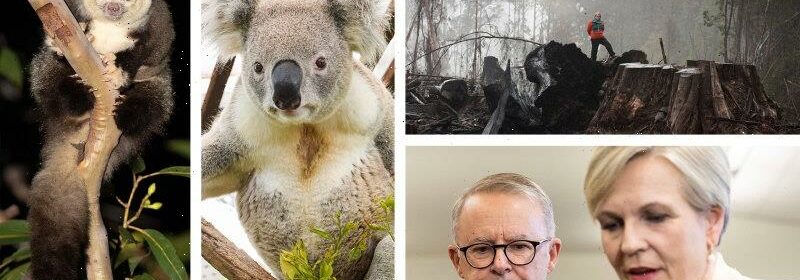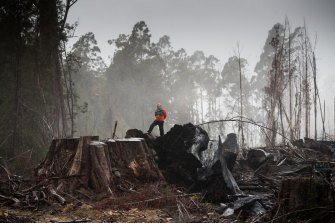Environment scorecard finds Australia’s habitat ‘crumbling rapidly’

Australia has suffered catastrophic losses of wildlife and habitat, according to the official five-year scorecard on the state of the environment, released on Tuesday, as leading scientists plead with the Albanese government to urgently ramp up protections to halt the escalating rate of extinction.
The latest State of the Environment report says Australia has lost the most mammals of any continent. More than 80 per cent of Australia’s nearly 400 mammal species, from furry greater gliders that fly across tree tops to egg-laying, poisonous platypus, are found nowhere else. Tragically, the 39 mammal species that have disappeared since colonisation in 1788 represent 38 per cent of the world’s lost mammals.
Logging coupes in the Huon Valley: land-clearing has been identified as a chief culprit in the escalating threat to Australia’s wildlife and habitat. Credit:Jason South
Since 2016, when the previous State of the Environment was released, 17 mammal species were either added to the endangered list or downgraded to the critically endangered list, as well as 17 birds and 19 frogs.
The extinction risk this month for greater gliders in NSW and Victoria has been upgraded by the federal government, which now rates the species once common in eastern forests as a risk of disappearing in coming years.
Once common in eastern forests, the animal akin to a flying koala has been pushed to the brink by habitat loss from logging, land clearing for agriculture, intensifying bushfires and rising average temperatures.
Prepared by a panel of 32 experts, the government-commissioned State of the Environment report says “increasing pressures from climate change, habitat loss, invasive species, pollution and resource extraction” have taken their toll on Australia’s deteriorating ecosystems.
Ecologists list land clearing as a top cause of wildlife losses and the State of the Environment report said between 2000 and 2017, there were 7.7 million hectares of land cleared across Australia and 93 per cent of the vegetation was felled without federal approvals for threatened species habitats.
Labor pledged during the federal election to overhaul environmental protection laws and issue a full response to the scathing findings of the Samuel Review of the Environment Protection and Biodiversity Conservation (EPBC) Act as well as establish new nature watchdogs with an Environmental Protection Agency and a National Water Commission.
But to deliver on its promises, federal Environment and Water Minister Tanya Plibersek must persuade the government to invest heavily in the environment as it reckons with government debt forecast to climb beyond $1 trillion in 2023-2024.
At her appearance at the National Press Club in Canberra on Tuesday, Plibersek is expected to respond to the report’s bleak findings.
Greens environment and water spokesperson Sarah Hanson-Young said the findings of the report demanded urgent reforms by federal government.
“Minister Plibersek faces a real test this week – halt extinction and start to address the impact of the climate crisis on our wildlife and natural environment or continue the neglect,” Hanson-Young said.
Professor Brendan Wintle, a global leader in conservation ecology, said current spending was just five per cent of what’s needed.
To address these warnings, Plibersek must take on powerful campaigners who resist tighter environment laws in the mining and agricultural industries, as well as the union-dominated logging workforce.
“There’s a huge problem with lack of enforcement and lack of monitoring (by government) and it appears at the moment a lack of political will to even take the relatively small steps towards solutions, let alone the hard steps,” Wintle said.
Wintle co-authored a detailed analysis of environment funding that found the federal government spent about $122 million a year on endangered wildlife, about 10 per cent of what was being spent in the United States.
“We need to increase our investment almost twentyfold to be able to actually prevent the further loss of species,” Wintle said.
“Unless we see a really dramatic increase (in funding) we’re going to see many, many more extinctions in the next 10 years.”
Shortly after being appointed to the portfolio, Plibersek in June told The Age and Sydney Morning Herald that she would not yet commit to deliver Labor’s election commitments in its first term.
“I don’t want to start putting timeframes on it just yet,” she said.
But speaking ahead of the report’s release Plibersek said it was time to “under Labor, the environment is back on the priority list”.
“Now is the time to read this report and take action,” she said.
Labor Environment Action Network, an influential group of left-faction party backers, said delivering the reforms as soon as possible was essential.
“We need to deliver law reform of the EPBC Act and create a federal Environment Protection Agency, then we need to end land-clearing and logging because anything short of this will fail and species will still continue to go backwards,” said LEAN co-convener Felicity Wade.
Eminent Australian ecologist Professor John Woinarski said the State of the Environment report was a landmark document that showed the need for immediate implementation of tighter regulations.
Wildlife losses had continued at a swift and damaging pace since colonisation of the continent, Woinarski says, but urban expansion, land clearing, feral pests, weeds and climate change will only accelerate the destruction.
The report said Australia now has more foreign plant species growing wild than natives, which coupled with climate change was reducing the abundance and location of plants that are culturally significant to First Nations peoples.
“This is actually a very pivotal time for the natural world and the legacy we leave out the descendants. If we don’t take greater action now, it will crumble rapidly before our eyes,” Woinarski said.
“We’re still clearing unsustainable rates, climate change will have both chronic and acute impacts on all our biodiversity including many of our most iconic sites like the Great Barrier Reef, the Gondwanan rainforest, the Blue Mountains and Kakadu.”
Cut through the noise of federal politics with news, views and expert analysis from Jacqueline Maley. Subscribers can sign up to our weekly Inside Politics newsletter here.
Most Viewed in Politics
From our partners
Source: Read Full Article
